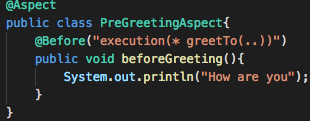一、AOP概念
在软件业,AOP为Aspect Oriented Programming的缩写,意为:面向切面编程,通过预编译方式和运行期动态代理实现程序功能的统一维护的一种技术。AOP是OOP的延续,是软件开发中的一个热点,也是Spring框架中的一个重要内容,是函数式编程的一种衍生范型。利用AOP可以对业务逻辑的各个部分进行隔离,从而使得业务逻辑各部分之间的耦合度降低,提高程序的可重用性,同时提高了开发的效率。AOP采取横向抽取机制,取代了传统纵向继承体系重复性代码.Spring AOP使用纯Java实现,不需要专门的编译过程和类加载器,在运行期通过代理方式向目标类织入增强代码。
在实际开发中,我们会有很多与我们业务逻辑无关但是又不得不写的代码,例如如果我们需要使用jwt签名验证我们需要在很多接口前都要进行签名的校验,根据签名的正确与否来决定是否拥有调用此接口的权利。如果我们在每一个接口前都进行这一系列的复杂校验,不仅会增加程序员的代码量,影响他们写业务逻辑的思路,也会造成代码的冗余,使同一功能代码书写多次。还包括权限检查、性能监控以及事务管理逻辑(都称为横切逻辑)。
二、AOP中常用的术语
- 连接点(Joinpoint): 所谓连接点是指那些被拦截到的点。在spring中,这些点指的是方法,因为spring只支持方法类型的连接点,也可以理解连接点为:目标类上哪些有可能被增强的方法。
- 切点(Pointcut):可以理解为查询条件。一个target(目标类)的所有方法都是连接点,切点可以通过查询条件定位特定的连接点。
- 增强(Advice):织入目标类连接点上的一段程序代码。既包含连接点上的执行逻辑(横切逻辑、增强逻辑)又包含定位连接点的方位信息,before、after、around等。增强默认织入目标类的所有方法中。
- 目标对象(Target):增强逻辑织入的目标类。
- 代理(Proxy):一个类被AOP植入增强后,被产生一个结果代理类。
- 织入(Weaving):将通知(增强)应用到连接点上,生成代理的过程。
- 切面(Aspect):由切点和增强组成。
- 引介(Introduction):引介是一种特殊的通知在不修改类代码的前提下, Introduction可以在运行期为类动态地添加一些方法或Field。

三、常见增强类型
- 前置增强(Beforeadvice): 在目标方法执行前实施增强
- 后置增强(Afterreturningadvice):在目标方法执行后实施增强
- 环绕增强(Aroundadvice):在目标方法执行前后实施增强
- 异常抛出增强(Throwsadvice):在方法抛出异常后实施增强
- 引介增强(IntroductionInterceptor):在目标类中添加一些新的方法和属性。
- final增强:可以看成异常抛出增强和后置增强的混合物,一般用于释放资源,相当于try finally的控制流。 AspectJ有此增强类型,Spring4.0中还没有此增强类型。
四、支撑Spring AOP的底层Java技术:动态代理
spring AOP核心技术就是使用了Java 的动态代理技术, 这里简单的总结下JDK和CGLIB两种动态代理机制.
概念:
当一个对象(客户端)不能或者不想直接引用另一个对象(目标对象),这时可以应用代理模式在这两者之间构建一个桥梁--代理对象。按照代理对象的创建时期不同,可以分为两种:
静态代理:程序员事先写好代理对象类,在程序发布前就已经存在了;
动态代理:应用程序发布后,通过动态创建代理对象。
其中动态代理又可分为:JDK/Cglib 动态代理。
4.1 JDK动态代理
此时代理对象和目标对象实现了相同的接口,目标对象作为代理对象的一个属性,具体接口实现中,可以在调用目标对象相应方法前后加上其他业务处理逻辑。
代理模式在实际使用时需要指定具体的目标对象,如果为每个类都添加一个代理类的话,会导致类很多,同时如果不知道具体类的话,怎样实现代理模式呢?这就引出动态代理。
JDK动态代理只能针对实现了接口的类生成代理。
代码实例:
UserService.java:
public interface UserService { public void save(); public void update(); public void delete(); public void find(); }
UserServiceImpl.java:
public class UserServiceImpl implements UserService { @Override public void save() { System.out.println("保存用户..."); } @Override public void update() { System.out.println("修改用户..."); } @Override public void delete() { System.out.println("删除用户..."); } @Override public void find() { System.out.println("查询用户..."); } }
MyJdbProxy.java:

/** * 使用JDK的动态代理实现代理机制 * */ public class MyJdbProxy implements InvocationHandler{ private UserService userService; public MyJdbProxy(UserService userService){ this.userService = userService; } public UserService createProxy(){ // 生成UserSErvice的代理: UserService userServiceProxy = (UserService) Proxy.newProxyInstance( userService.getClass().getClassLoader(), userService.getClass() .getInterfaces(), this); return userServiceProxy; } @Override public Object invoke(Object proxy, Method method, Object[] args) throws Throwable { // 判断是否是save方法: if("save".equals(method.getName())){ // 增强: System.out.println("权限校验==========="); return method.invoke(userService, args); } return method.invoke(userService, args); } }
SpringDemo.java 测试类:
public class SpringDemo1 { @Test // 没有代理的时候的调用方式 public void demo1() { // 创建目标对象 UserService userService = new UserServiceImpl(); userService.save(); userService.update(); userService.delete(); userService.find(); } @Test // 使用代理 public void demo2() { // 创建目标对象 UserService userService = new UserServiceImpl(); UserService proxy = new MyJdbProxy(userService).createProxy(); proxy.save(); proxy.update(); proxy.delete(); proxy.find(); } }
4.1 CGLib动态代理
CGLIB(CODE GENERLIZE LIBRARY)代理是针对类实现代理,主要是对指定的类生成一个子类,覆盖其中的所有方法,所以该类或方法不能声明称final的。CGLib采用底层的字节码技术,可以为一个类创建子类,在子类中采用方法拦截的技术拦截所以弗雷方法的调用并顺势织入横切逻辑。
如果目标对象没有实现接口,则默认会采用CGLIB代理;
如果目标对象实现了接口,可以强制使用CGLIB实现代理(添加CGLIB库,并在spring配置中加入<aop:aspectj-autoproxy proxy-target-class="true"/>
代码实例:
CustomerService.java:
public class CustomerService { public void save(){ System.out.println("保存客户..."); } public void update(){ System.out.println("修改客户..."); } public void delete(){ System.out.println("删除客户..."); } public void find(){ System.out.println("查询客户..."); } }
MyCglibProxy.java:
/** * 使用Cglib产生代理 * */ public class MyCglibProxy implements MethodInterceptor{ private CustomerService customerService; public MyCglibProxy(CustomerService customerService){ this.customerService = customerService; } public CustomerService createProxy(){ // 创建核心类: Enhancer enhancer = new Enhancer(); // 设置父类: enhancer.setSuperclass(customerService.getClass()); // 设置回调: enhancer.setCallback(this); // 创建代理: CustomerService customerServiceProxy = (CustomerService) enhancer.create(); return customerServiceProxy; } @Override public Object intercept(Object proxy, Method method, Object[] arg, MethodProxy methodProxy) throws Throwable { if("delete".equals(method.getName())){ Object obj = methodProxy.invokeSuper(proxy, arg); System.out.println("日志记录=========="); return obj; } return methodProxy.invokeSuper(proxy, arg); } }
SpringDemo.java 测试类:
public class SpringDemo2 { @Test public void demo1(){ CustomerService customerService = new CustomerService(); customerService.save(); customerService.update(); customerService.delete(); customerService.find(); } @Test public void demo2(){ CustomerService customerService = new CustomerService(); // 产生代理: CustomerService proxy = new MyCglibProxy(customerService).createProxy(); proxy.save(); proxy.update(); proxy.delete(); proxy.find(); } }
五、Spring的传统的AOP:基于ProxyFactoryBean的方式的代理与BeanPostProcesser自动代理
5.1 使用ProxyFactoryBean配置代理
<bean id="greetingAdvice" class="com.smart.advice.GreetingBeforeAdvice" /> <bean id="target" class="com.smart.advice.NaiveWaiter" /> <bean id="waiter" class="org.springframework.aop.framework.ProxyFactoryBean" p:proxyInterfaces="com.smart.advice.Waiter" p:target-ref="target" p:interceptorNames="greetingAdvice" />
根据Advisor代理,proxyTargetClass设置为true,采用了CGLib动态代理技术(创建子类来代理target对象)
<bean id="waiterTarget" class="com.smart.advisor.Waiter" /> <bean id="sellerTarget" class="com.smart.advisor.Seller" /> <bean id="greetingAdvice" class="com.smart.advisor.GreetingBeforeAdvice" /> <!-- 正则表达式方法名匹配切面 --> <bean id="regexpAdvisor" class="org.springframework.aop.support.RegexpMethodPointcutAdvisor" p:advice-ref="greetingAdvice"> <property name="patterns"> <list> <value>.*greet.*</value> </list> </property> </bean> <bean id="waiter1" class="org.springframework.aop.framework.ProxyFactoryBean" p:interceptorNames="regexpAdvisor" p:target-ref="waiterTarget" p:proxyTargetClass="true" />